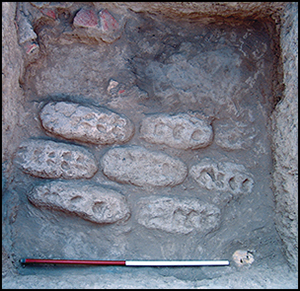Crossref Citations
This article has been cited by the following publications. This list is generated based on data provided by
Crossref.
2015.
Current Bibliography of the History of Science and Its Cultural Influences, 2015.
Isis,
Vol. 106,
Issue. S1,
p.
i.
Broushaki, Farnaz
Thomas, Mark G.
Link, Vivian
López, Saioa
van Dorp, Lucy
Kirsanow, Karola
Hofmanová, Zuzana
Diekmann, Yoan
Cassidy, Lara M.
Díez-del-Molino, David
Kousathanas, Athanasios
Sell, Christian
Robson, Harry K.
Martiniano, Rui
Blöcher, Jens
Scheu, Amelie
Kreutzer, Susanne
Bollongino, Ruth
Bobo, Dean
Davoudi, Hossein
Munoz, Olivia
Currat, Mathias
Abdi, Kamyar
Biglari, Fereidoun
Craig, Oliver E.
Bradley, Daniel G.
Shennan, Stephen
Veeramah, Krishna R.
Mashkour, Marjan
Wegmann, Daniel
Hellenthal, Garrett
and
Burger, Joachim
2016.
Early Neolithic genomes from the eastern Fertile Crescent.
Science,
Vol. 353,
Issue. 6298,
p.
499.
Shumilovskikh, Lyudmila S
Hopper, Kristen
Djamali, Morteza
Ponel, Philippe
Demory, Franҫois
Rostek, Frauke
Tachikawa, Kazuyo
Bittmann, Felix
Golyeva, Alexandra
Guibal, Frédéric
Talon, Brigitte
Wang, Liang-Chi
Nezamabadi, Masoud
Bard, Edouard
Lahijani, Hamid
Nokandeh, Jebrael
Omrani Rekavandi, Hamid
de Beaulieu, Jacques-Louis
Sauer, Eberhard
and
Andrieu-Ponel, Valérie
2016.
Landscape evolution and agro-sylvo-pastoral activities on the Gorgan Plain (NE Iran) in the last 6000 years.
The Holocene,
Vol. 26,
Issue. 10,
p.
1676.
Stevens, Chris J
Murphy, Charlene
Roberts, Rebecca
Lucas, Leilani
Silva, Fabio
and
Fuller, Dorian Q
2016.
Between China and South Asia: A Middle Asian corridor of crop dispersal and agricultural innovation in the Bronze Age.
The Holocene,
Vol. 26,
Issue. 10,
p.
1541.
Bhatti, Shahzad
Aslamkhan, Muhammad
Attimonelli, Marcella
Abbas, Sana
and
Aydin, Hikmet Hakan
2017.
Mitochondrial DNA variation in the Sindh population of Pakistan.
Australian Journal of Forensic Sciences,
Vol. 49,
Issue. 2,
p.
201.
Roustaei, Kourosh
and
Nokandeh, Jebrael
2017.
Neolithic developments in the Gorgan Plain, south-east of the Caspian Sea.
Antiquity,
Vol. 91,
Issue. 358,
Jelodar, Mohammad Esmaeil Esmaeili
2018.
The first possible evidence of the Aceramic Neolithic in the Iranian Central Plateau.
Antiquity,
Vol. 92,
Issue. 362,
Barge, Olivier
Azizi Kharanaghi, Hossein
Biglari, Feiredoun
Moradi, Babak
Mashkour, Marjan
Tengberg, Margareta
and
Chataigner, Christine
2018.
Diffusion of Anatolian and Caucasian obsidian in the Zagros Mountains and the highlands of Iran: Elements of explanation in 'least cost path' models.
Quaternary International,
Vol. 467,
Issue. ,
p.
297.
Manca, Laura
Mashkour, Marjan
Shidrang, Sonia
Averbouh, Aline
and
Biglari, Fereidoun
2018.
Bone, shell tools and ornaments from the Epipalaeolithic site of Ali Tappeh, East of Alborz Range, Iran.
Journal of Archaeological Science: Reports,
Vol. 21,
Issue. ,
p.
137.
Daly, Kevin G.
Maisano Delser, Pierpaolo
Mullin, Victoria E.
Scheu, Amelie
Mattiangeli, Valeria
Teasdale, Matthew D.
Hare, Andrew J.
Burger, Joachim
Verdugo, Marta Pereira
Collins, Matthew J.
Kehati, Ron
Erek, Cevdet Merih
Bar-Oz, Guy
Pompanon, François
Cumer, Tristan
Çakırlar, Canan
Mohaseb, Azadeh Fatemeh
Decruyenaere, Delphine
Davoudi, Hossein
Çevik, Özlem
Rollefson, Gary
Vigne, Jean-Denis
Khazaeli, Roya
Fathi, Homa
Doost, Sanaz Beizaee
Rahimi Sorkhani, Roghayeh
Vahdati, Ali Akbar
Sauer, Eberhard W.
Azizi Kharanaghi, Hossein
Maziar, Sepideh
Gasparian, Boris
Pinhasi, Ron
Martin, Louise
Orton, David
Arbuckle, Benjamin S.
Benecke, Norbert
Manica, Andrea
Horwitz, Liora Kolska
Mashkour, Marjan
and
Bradley, Daniel G.
2018.
Ancient goat genomes reveal mosaic domestication in the Fertile Crescent.
Science,
Vol. 361,
Issue. 6397,
p.
85.
Lister, Diane L.
Jones, Huw
Oliveira, Hugo R.
Petrie, Cameron A.
Liu, Xinyi
Cockram, James
Kneale, Catherine J.
Kovaleva, Olga
Jones, Martin K.
and
Sun, Genlou
2018.
Barley heads east: Genetic analyses reveal routes of spread through diverse Eurasian landscapes.
PLOS ONE,
Vol. 13,
Issue. 7,
p.
e0196652.
Vahdati Nasab, Hamed
Shirvani, Sanaz
and
Rigaud, Solange
2019.
The Northern Iranian Central Plateau at the End of the Pleistocene and Early Holocene: The Emergence of Domestication.
Journal of World Prehistory,
Vol. 32,
Issue. 3,
p.
287.
Dana, Mohsen
and
Hozhabri, Ali
2019.
The Role of Cultural Factors in Locating of Archaeological Sites: the Settlement Patterns of Prehistoric Sites in Jājarm, Khorasan, Iran.
Iran,
Vol. 57,
Issue. 2,
p.
123.
Verdugo, Marta Pereira
Mullin, Victoria E.
Scheu, Amelie
Mattiangeli, Valeria
Daly, Kevin G.
Maisano Delser, Pierpaolo
Hare, Andrew J.
Burger, Joachim
Collins, Matthew J.
Kehati, Ron
Hesse, Paula
Fulton, Deirdre
Sauer, Eberhard W.
Mohaseb, Fatemeh A.
Davoudi, Hossein
Khazaeli, Roya
Lhuillier, Johanna
Rapin, Claude
Ebrahimi, Saeed
Khasanov, Mutalib
Vahidi, S. M. Farhad
MacHugh, David E.
Ertuğrul, Okan
Koukouli-Chrysanthaki, Chaido
Sampson, Adamantios
Kazantzis, George
Kontopoulos, Ioannis
Bulatovic, Jelena
Stojanović, Ivana
Mikdad, Abdesalam
Benecke, Norbert
Linstädter, Jörg
Sablin, Mikhail
Bendrey, Robin
Gourichon, Lionel
Arbuckle, Benjamin S.
Mashkour, Marjan
Orton, David
Horwitz, Liora Kolska
Teasdale, Matthew D.
and
Bradley, Daniel G.
2019.
Ancient cattle genomics, origins, and rapid turnover in the Fertile Crescent.
Science,
Vol. 365,
Issue. 6449,
p.
173.
Betts, Alison
Yatoo, Mumtaz
Spate, Michael
Fraser, James
Kaloo, Zahoor
Rashid, Younus
Pokharia, Anil
and
Zhang, Guilin
2019.
The Northern Neolithic of the Western Himalayas: New Research in the Kashmir Valley.
Archaeological Research in Asia,
Vol. 18,
Issue. ,
p.
17.
Roustaei, Kourosh
and
Gratuze, Bernard
2020.
Eastward expansion of the Neolithic from the Zagros: Obsidian provenience from Sang-e Chakhmaq, a late 8th-early 7th millennia BCE Neolithic site in northeast Iran.
Journal of Archaeological Science: Reports,
Vol. 29,
Issue. ,
p.
101969.
Oudbashi, Omid
Naseri, Reza
Cultrone, Giuseppe
Egartner, Isabel
and
Arizzi, Anna
2021.
The pottery production from the Deh Dumen Bronze Age graveyard (South-Western Iran): a chemical, mineralogical and physical study.
Heritage Science,
Vol. 9,
Issue. 1,
Roustaei, Kourosh
and
Rezvani, Hasan
2021.
New Evidence of Two Transitions in the Neolithic Sequence of Northeastern Iran.
Near Eastern Archaeology,
Vol. 84,
Issue. 4,
p.
252.
Nishiaki, Yoshihiro
Aripdjanov, Otabek
Arai, Saiji
Akashi, Chie
Nakata, Hiroto
Sayfullayev, Bakhtiyor
Ergashev, Odil
and
Suleimanov, Rustam
2022.
Neolithization during the 6th millennium BCE in western Central Asia: New evidence from Kaynar Kamar Rockshelter, Hissar Mountains, Southeast Uzbekistan.
Archaeological Research in Asia,
Vol. 30,
Issue. ,
p.
100352.
Mutin, Benjamin
2022.
Les premiers villages agricoles de l’est du plateau Iranien à la vallée de l’Indus : état de la question.
L'Anthropologie,
Vol. 126,
Issue. 3,
p.
103050.
